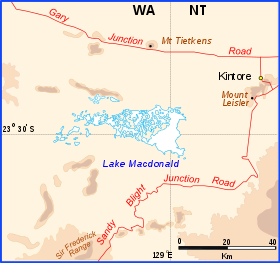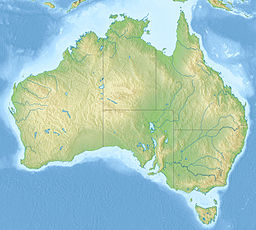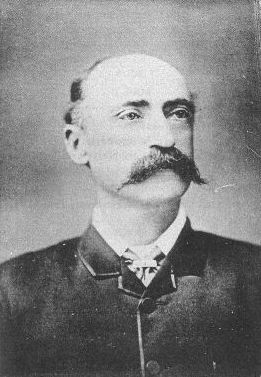
William Ernest Powell Giles, best known as Ernest Giles, was an Australian explorer who led five major expeditions to parts of South Australia and Western Australia.

Baron Sir Ferdinand Jacob Heinrich von Mueller, was a German-Australian physician, geographer, and most notably, a botanist. He was appointed government botanist for the then colony of Victoria, Australia by Governor Charles La Trobe in 1853, and later director of the Royal Botanic Gardens in Melbourne. He also founded the National Herbarium of Victoria. He named many Australian plants.
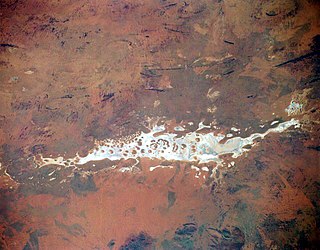
Lake Amadeus is a large salt lake in the southwest corner of Northern Territory of Australia, about 50 kilometres (31 mi) north of Uluru. The smaller Lake Neale is adjacent to the northwest. It is part of the Amadeus Basin that was filled with the erosion products of the Petermann Orogeny.

Papunya is a small Indigenous Australian community roughly 240 kilometres (150 mi) northwest of Alice Springs (Mparntwe) in the Northern Territory, Australia. It is known as an important centre for Contemporary Indigenous Australian art, in particular the style created by the Papunya Tula artists in the 1970s, referred to colloquially as dot painting. Its population in 2016 was 404.
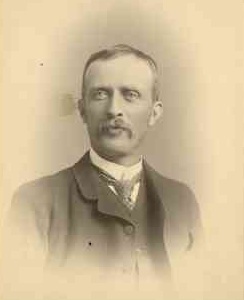
Henry Yorke Lyell Brown FGS was an Australian geologist.
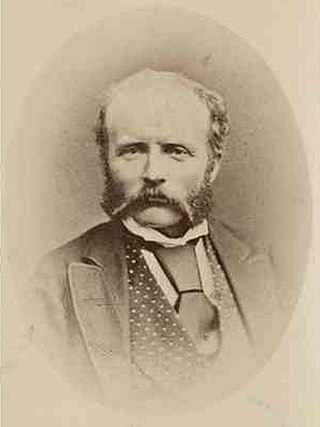
William Harry Tietkens, known as "Harry Tietkens", explorer and naturalist, was born in England and emigrated to Australia in 1859. Tietkens was second in command to Ernest Giles on expeditions to Central Australia in 1873 and on a journey from Beltana, South Australia to Perth, Western Australia in 1875. In 1889 Tietkens led his own expedition west of Alice Springs to the vicinity of the Western Australian border. This expedition discovered Lake Macdonald, the Kintore Range, Mount Leisler, Mount Rennie, the Cleland Hills, defined the western borders of Lake Amadeus, and photographed Uluru and Kata Tjuta for the first time. The expedition collected new species of plants and rock samples allowing the South Australian government geologist to compile a 'geological sketch' of the country traversed. Tietkens was elected a fellow of the Royal Geographical Society on his return. Specimens of 250 plant species were collected, although only 8 were new to science, and in 1890, Ferdinand von Mueller and Ralph Tate named Eremophila tietkensii in his honour.

John McKinlay was a Scottish-born Australian explorer and cattle grazier, and leader of the South Australian Burke Relief Expedition - one of the search parties for the Burke and Wills expedition. McKinlay was also a member of Charles Sturt's Central Exploring Expedition from 1844-1845. The town of McKinlay in northwestern Queensland is named after him.
Kiwirrkurra, gazetted as Kiwirrkurra Community, is a small community in Western Australia in the Gibson Desert, 1,200 kilometres (750 mi) east of Port Hedland and 700 kilometres (430 mi) west of Alice Springs. It had a population of 165 in 2016, mostly Aboriginal Australians. It has been described as the most remote community in Australia.
Takariya Napaltjarri is an Indigenous artist from Australia's Western Desert region. She has painted with Papunya Tula artists' cooperative. First exhibited in 1996, her work is held in the collection of the Art Gallery of New South Wales.
Topsy Gibson Napaltjarri, also known as Tjayika or Tjanika, is a Pintupi-speaking Indigenous artist from Australia's Western Desert region.
Molly Jugadai Napaltjarri (c.1954–2011) was a Pintupi- and Luritja-speaking Aboriginal artist from Australia's Western Desert region. Her paintings are held in major collections, including the National Gallery of Australia.
On 22 June 1883, the Geographical Society of Australasia started at a meeting in Sydney, New South Wales, Australia. A branch was formed in Victoria in the same year. In July 1885, both the Queensland and the South Australian branches started.
Mount Unapproachable is an isolated mountain in the Northern Territory of Australia located in the locality of Petermann on the northern side of Lake Neale in the territory's southwest. It is about 505 metres (1,657 ft) above sea level. The area is remote: the nearest towns are Kaltukatjara some 116 kilometres (72 mi) away, Kintore some 135 kilometres (84 mi) away and Yulara 138 kilometres (86 mi) away. The mountain is mostly made of sandstone.
Bloods Range is a mountain range in central Australia, stretching roughly east to west across the border between the Northern Territory and Western Australia. It consists of several sets of hills, separated by valleys; the two main valleys are formed by the Hull and Docker Rivers. There are numerous ravines and gorges all throughout the hills. Bloods Range connects with the Petermann Ranges at its western end. In the centre are Mounts Harris (840 m) and Carruthers (1000 m), which are the highest peaks. Further east, the range splits into several branches, including the Rowley Range, McNichol's Range and the Pinyinna Range.
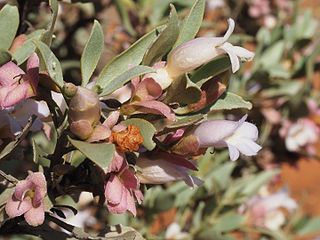
Eremophila tietkensii is a flowering plant in the figwort family, Scrophulariaceae and is endemic to Australia. It is a rounded to flat-topped shrub with grey-green leaves, usually pinkish-purple sepals and mauve, pink or lilac-coloured petals. It is mostly found in Western Australia but also occurs in the far west of the Northern Territory.

The Tietkens expedition of 1889 was led by William Tietkens. It covered territory west of Alice Springs to the vicinity of the Western Australian border.
Narputta Nangala Jugadai (1933–2010) was an Aboriginal Australian artist born at Karrkurutinytja, who later lived at Haasts Bluff (Ikuntji) in the Northern Territory. Her language group was Pintupi/Pitjantjatjara, and her Dreaming was "Snake", "Jangala, Two Men" and "Two Women". She was a senior artist in her community at Ikuntji and prominent among the Ikuntji Women's Centre painters. She was the wife of the painter, Timmy Tjungurrayi Jugadai, and mother of Daisy Jugadai Napaltjarri and Molly Jugadai Napaltjarri.

Ningura Napurrula was a Pintupi-speaking Indigenous Australian artist from the Western Desert, whose work was internationally acclaimed. Her works included a site-specific commission for the ceiling of the Musée du Quai Branly in Paris, as well as appearing on an Australian postage stamp.
Yinarupa Nangala is a Pintupi from Western Australia. just west of the Kiwirrkurra community. Her works are held in major art collections including the Art Gallery of NSW, Museum and Art Gallery of the Northern Territory, and the National Gallery of Victoria.
Yala Yala Gibbs Tjungarrayi was a Pintupi-speaking Indigenous Australian artist. He was born at Iltuturunga, south-west of Lake Macdonald, in the Western Desert, close to the border of Western Australia and the Northern Terriitory. In 1963, together with his family he moved to Papunya in the Northern Territory. Tjungarrayi was one of the first group of artists painting in the Papunya Tula cooperative from its beginnings in 1971. His wife was Ningura Napurrla, another Papunya Tula artist. He was a custodian of Pintupi sacred ceremonies and sites.
